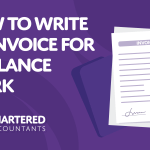Invoicing is a crucial aspect of freelance work. Handling the process correctly and having the right systems in place ensures you get paid for your services on time while helping you to maintain a professional relationship with your clients and stay compliant with HMRC’s rules and regulations.
Whether you’re new to freelancing or looking to refine your invoicing process, this guide will help you understand the right freelancer invoice format and help you get paid on time.
👉 Download our free freelance invoice template here to get started with your invoicing quickly and easily.
What Is An Invoice?
An invoice tells the customer what they need to pay, when payment is due, and how they need to pay you. It also helps your business keep track of what it’s owed.
An invoice for freelance work typically doesn’t need to be signed by both parties, as it primarily serves as a formal request for payment rather than a legally binding agreement. However, some clients may require a signed contract or agreement outlining terms, conditions, and payment details before work begins.
Should I Add VAT to My Invoice?
One common question freelancers ask is whether to add VAT (Value Added Tax) to their invoices. The answer depends on your VAT registration status.
- If your annual turnover exceeds the VAT threshold (currently £90,000 in the UK), you must register for VAT and charge it on your invoices.
- If your turnover is below the threshold, you can voluntarily register for VAT. This can be beneficial if your clients are VAT registered businesses because they can reclaim the VAT you charge.
- You should not add VAT to your invoices if you are not VAT registered.
You can register for VAT at gov.uk/register-for-vat.
Charging VAT:
Once registered, you need to:
- Include your VAT number on your invoices
- Clearly show the VAT amount as a separate line item
- Specify the VAT rate (standard, reduced or zero rate)
- Indicate the total amount inclusive of VAT
Example VAT calculation: If you charge £1,000 for your services and the VAT rate is 20%, your invoice should show:
- Service fee: £1,000
- VAT (20%): £200
- Total: £1,200
Overseas Clients
VAT on the sale of goods or services to businesses outside the UK is complex and you should discuss this with your accountant.
What Does a Freelancer Invoice Look Like?
Creating a professional and clear invoice is essential for getting paid on time and maintaining strong client relationships. The freelancer invoice format can vary depending on your work, but the following details are generally required:
Your Information:
- Business name (or your name, if you’re a sole trader)
- Trading address
- Registered office (if a limited company and different to trading address above)
- Contact details (phone number, email)
- VAT number (if applicable)
- Company number (if a limited company)
Client Information:
- Client’s business name
- Address
- Contact person (if applicable)
Invoice Details:
- Invoice number – A unique identifier for your invoice. This can also be added to the subject line of your email when you invoice.
- Invoice date: The date when the invoice is issued.
- Due date: When the payment is expected (typically immediate payment or within 30 days).
Services Description:
- Detailed description of the services provided
- Dates when the services were performed
- Hourly rate or fixed fee for each service
- Quantity (hours worked, units provided, etc.)
Financial Details:
- Subtotal (before taxes and discounts)
- VAT amount (if applicable)
- Discounts (if any)
- Total amount due
Payment Terms:
- Preferred payment methods (bank transfer, PayPal, etc.)
- Bank details (account number, sort code, IBAN, BIC/SWIFT for international payments)
- Payment terms (e.g. due within 30 days)
Additional Information:
- Late payment policy (any interest or fees for overdue payments)
- Their purchase order reference (if applicable)
- Notes or thank you message
👉 Download our free freelance invoice example here and use it as a template to create your own professional invoices.
How to Chase Payment on Invoices
An invoice is the first step to getting paid, and with our template above, you’re providing all the important information including when the invoice needs to be paid.
But in some instances, there can be delays in getting paid, which is when you need to take the following steps:
- Contact the customer a few days before the invoice is due to check they have everything they need and that the invoice will be paid by the due date.
If the invoice date has passed, follow up the client and politely remind them of the payment terms. - According to the UK Government, a payment becomes late 30 days after invoicing if no prior terms have been agreed. Small businesses can charge up to 8% interest plus base rate on late payments.
- If you’ve still not been paid, call the client to discuss.
- If payment isn’t agreed within 30-60 days, consider legal action, such as a small claims court, solicitor letters, or debt collection (typically taking around 25% of the debt as a fee).
- A series of letters at 7, 14 and 21 days overdue can be effective – with the final one warning of legal action.
- If using cloud accounts software, you will probably be able to automate this process.
Creating clear and professional invoices helps ensure you get paid on time and gives you more credibility as a freelancer. You could even go one step further and add a note to say thanks for working with you.
At 360 Accountants, we can help you to keep accurate bookkeeping and accounting records, including invoicing. Contact us on 01482 427360 for more information.
FAQs About Freelance Invoices
How do I invoice as a freelancer?
You can invoice as a freelancer by creating a document that follows the standard freelancer invoice format. Include your details, client details, invoice number, services provided, and payment terms.
What is an invoice number?
An invoice number is a unique reference code you assign to each invoice, helping you and your client track payments and avoid confusion.
Do I need to put tax on my invoice?
You only need to add VAT if you’re VAT registered. If not, your invoice should just show the net amount owed.
Do I need to have a company to send an invoice?
No. Freelancers and sole traders can issue invoices in their own name, as long as they include the necessary details.
When should I raise a sales invoice?
Generally as soon as the goods have been sent (or the service provided), otherwise the payment is likely to be delayed




